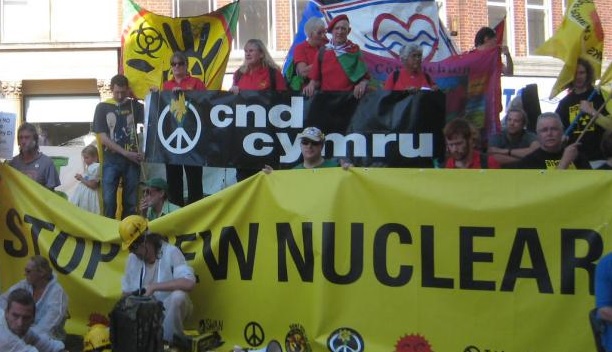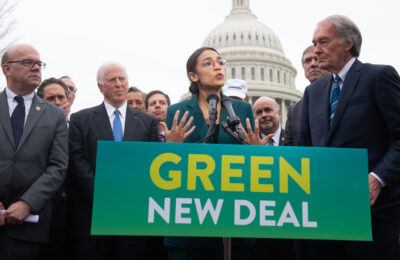By rights, the idea of nuclear power stations as sustainable and environmentally neutral sources of energy in Britain’s electricity generation system should be dead in the water, writes Sean Thompson.

While the catastrophic explosions at Chernobyl in 1986, and Fukushima in 2011 demonstrated that, like all sophisticated systems, nuclear technology is vulnerable to both human error and natural disaster – and capable of causing massive environmental damage – it is the icy logic of profit and loss that should have provided the coup de grace for the nuclear industry. Nuclear energy is not only potentially hugely dangerous, it no longer makes economic sense.
The UK has 8 nuclear power stations currently producing about 19% of the country’s electricity. The most recent was built twenty six years ago and all but one are scheduled to be closed by the end of 2030. To fill the anticipated ‘energy gap’, the government wants to build a new generation of nuclear power stations, but with the collapse of the plans to build a new reactor at Wylfa on Anglesey the only power plant currently under construction (and therefore potentially able to help bridge the 2030 ‘energy gap’) is Hinkley Point C, in Somerset.
At the end of January, EDF admitted that the project completion cost at Hinkley Point C is now estimated at £22 billion to £23 billion, £500,000,000 more than estimated in 2019 and £5 billion more than originally estimated in 2016. EDF has negotiated a guaranteed fixed price for electricity from Hinkley of £92.50/MWh in 2012 prices, which will be adjusted (linked to inflation) during the construction period and over the subsequent 35 year tariff period. In comparison, the record-low prices for off-shore wind power will see new build projects due to start operating in 2023/24 coming in at £39.65/MWh and those for 2024/25 at £41.61/MWh. These are some £8-9/MWh below the government’s ‘reference price’; the level it expects to see for electricity on the open market in each year.
In July 2016, the National Audit Office estimated that due to falling energy costs, the additional cost to consumers of ‘future top-up payments…had increased from £6.1 billion in October 2013, when the strike price was agreed, to £29.7 billion’. No wonder that the NAO’s assessment in 2017 was that “the Department for Business, Energy and Industrial Strategy’s deal for Hinkley Point C has locked consumers into a risky and expensive project with uncertain strategic and economic benefits.”
Huge nuclear projects like Hinkley are clearly dinosaurs; too slow to build and too expensive to run. So, in its desperate search for something like a business as usual future the nuclear industry around the world has alighted on the idea of Small Modular Reactors (SMRs). In 2019, Rolls Royce received £18 million from the government to begin designing a modular 440 MW SMR unit and the government is proposing to spend £215m subsidising the construction of up to 16 SMRs. The key advantage of SMRs and other similar examples of what the Tory government calls ‘Advanced Nuclear Technologies’ is that they will be smaller than standard nuclear reactors and are largely constructed off-site and then transported. As a result, it is said, they will be cheaper build and to run. Of course, small and cheap are relative terms. Rolls Royce claims that an SMR power station will be ‘small enough to fit inside Wembley Stadium’, and in terms of cheapness, it hopes that the cost will be just £60 per MWh (although a study led by the US National Nuclear Laboratory gives a best estimate of over £80/MWh).
Rolls Royce’s (optimistic) target cost for their design is £1.8 billion, but only for the fifth unit built – the first working examples would obviously be hugely more than that. In addition, Rolls Royce admit that their business model relies on them not only building up to 16 plants in Britain but also selling many more internationally. The problem is that governments and power companies started building larger reactors in the first place because they produce electricity at a much lower cost than smaller ones, due to the principle of economies of scale. So even if small modular reactors were cheaper to build than a large reactor on a per-unit basis, they would be less cost-competitive on a per-kilowatt basis, putting enormous pressure on reactor designers and manufacturers to slash the costs of construction and operation to make small reactors cost-effective.
Even if Rolls Royce were able to hit their construction cost target – which would be a unique achievement for the nuclear industry – they themselves admit that the price of SMR generated electricity would be (optimistically) £60/MWh. To put that cost in context, the most recent Department for Business, Energy and Industrial Strategy (BEIS) forecast is that offshore wind projects which come online between now and 2030 will produce power at an average cost of £47 per megawatt-hour over the course of their lifetime. BEIS’s previous forecast had placed the figure at £103 per megawatt-hour. From both being forecast at £64/MWh in 2016, the equivalent figures for onshore wind and large-scale solar have also fallen, to £45/MWh and £39/MWh respectively.In comparison, BEIS is forecasting that the levelised cost of energy (LCOE) for new gas will reach £82/MWh by 2030 and that the LCOE for new nuclear will reach £93/MWh within the same timeframe.
The SMR lobby argues that mass-producing the reactors on an assembly line instead of building customised reactors on site would cut costs. However, the Union of Concerned Scientists’ report Small isn’t Always Beautiful says that this is an unproven proposition and warns that any benefits of manufacturing reactors on a production line could be undercut by generic defects that would spread throughout the entire reactor fleet. For example, in the US, problems with modular construction already have delayed four new AP1000 reactors in Georgia and South Carolina. ‘It will take many years of manufacturing experience before the industry will be able to confirm that small reactors can be built as cheaply as they say,’ says the report. ‘And that means that it will take massive taxpayer subsidies to get this industry off the ground.’
Clearly, there is no economic case for nuclear, the technology itself remains unforgiving of design or human operating errors and natural disasters and the problem of safely dealing with the ever growing mountain of toxic waste for centuries into the future remains unsolved. But the nuclear lobby’s final argument is that nuclear is a necessary component of the UK energy mix because of the intermittent nature of wind and solar electricity generation. The main claim now used to justify nuclear is that it’s the only low carbon power source that can supply ‘reliable, base load electricity’. But not only can renewables supply baseload power, they can do something far more valuable: supply power flexibly according to demand.
Underlying the nuclear lobby’s claim are three key assumptions. First, that baseload power is actually necessary and desirable. In fact, what it really means is too much power when we don’t want it, and not enough when we do. What we actually need is flexible power – and flexible demand too – so that supply and demand can be matched instant by instant.
The second assumption is that nuclear power is a reliable baseload supplier. In fact it’s no such thing. All nuclear power stations are subject to tripping out for safety reasons or technical faults at any time. The UK’s current theoretical nuclear generation capacity is 9.4GW and the average nuclear load factor is around 75%. That means that at least 2.3GW of nuclear capacity is likely to be out of action at any one time for maintenance or safety reasons and that nuclear’s theoretical generating capacity has to be matched by expensive ‘spinning reserve’ (usually in the form of gas powered power stations) that can be called in at a moment’s notice.
The third assumption is that the only way to supply baseload power is from power stations, such as nuclear, coal and gas, that are designed to run flat-out all the time whether their power is actually needed or not. That’s wrong too.There are an increasing number of renewable energy technologies which can supply baseload power. The intermittency of sources such as wind and solar photovoltaic can be addressed by a ‘smart grid’ interconnecting power plants which are widely geographically distributed, and by coupling them with peak-load plants such as gas turbines fuelled by biogas or hydrogen which can quickly be switched on to fill in gaps of low wind or solar production.
The Britain Isles are the windiest region in Europe. The UK has the largest installed capacity of offshore wind turbines in the world, with around 10GW in operation off its coasts, with plans in place to expand this to 40GW by 2030, and in addition, the UK has over 12 gigawatts of installed onshore wind capacity. Britain also experiences some of the highest tidal ranges in the world (up to 15m in the Bristol Channel) and the government’s own estimates show that tidal power could meet around 20% of our electricity demands, an amount that equates to an installed capacity of around 30 to 50 GW delivering in the region of 90 to 200 TWh per year. And, unlike the various theoretical technologies that will have to be developed to make SMRs viable, the technology already exists to store surplus energy from renewable but fluctuating energy sources in the form of hydrogen produced by electrolysis and/or modular liquified air plants like the one currently under construction in Sheffield.
Boris Johnson, when he isn’t enthusing over the idea of building a bridge between Stranraer and Larne or boasting about his government’s ‘world beating’ response to the Covid pandemic, is energetically talking up the the development of SMRs as part of his ‘Clean Growth Grand Challenge’. By 2050, the government says a full UK programme of up to 16 domestic SMRs could create up to 40,000 jobs and £52 billion of value to the UK economy, while creating the potential for the UK SMR export market to reach £250 billion. In reality, this is just a combination of frenetic lobbying by an obsolete industry and the bullshitting of politicians addicted to Grand Projects, from Heathrow Terminal 3 to HS2, that benefit no-one but their corporate donors.
But time is running out for the nuclear industry; according to the estimates of the annual World Nuclear Industry Status Report, over the past decade, the levelised costs – which compare the total lifetime cost of building and running a plant to lifetime output – for utility-scale solar have dropped by 88% and for wind by 69%. For nuclear, they have increased by 23%. In the end, the promotion of SMRs by industry lobbyists is unlikely to save the nuclear industry – its fate is being sealed by the hard facts of the balance sheet and the relentless advance of sustainable technology.



I am in complete agreement with Sean that the problems with all forms of nuclear electricity generation mean that it should be phased out rather than expanded. But I think it is important to acknowledge that nuclear currently does meet certain “needs” for electrical energy that it is difficult to meet using wind and solar – even in the (currently theoretical) presence of storage options. This is why the technology is seen as attractive even by committed environmentalists like George Monbiot. You only have to look at the electricity sources for the dates 1-9 March 2021 (https://gridwatch.co.uk/) to see that under certain conditions wind and solar cannot generate enough electricity to meet current “needs”. With several days’ worth of next-to-no wind and winter levels of solar radiation, storage options wouldn’t help much either, unless you had a system of generation and storage that was wildly over capacity. Currently, offshore wind operates at about 38% of capacity and onshore at 25%, reflecting the intermittency of wind, but what do you do when it is at 5% for several days?
There is a therefore a need to look for political and social solutions that are compatible with a massive reduction in energy use in the more industrialised economies (and in the over-developed sectors of the poorer countries – sectors that only serve the interests of the ruling classes there). Such solutions are not compatible with capitalism, which requires continuous growth in both GDP and energy supply and use (https://www.sciencedirect.com/science/article/pii/S1364032121000769). Even then, I anticipate that in the future – if we are not to rely on building huge new industrial energy supply sectors, with all the ecological consequences that they have – we will have periods where many of us have to endure levels of energy deprivation and discomfort that we have not experienced for a long time. If there are significant periods where our current RE cannot event meet 5% of our electricity needs (less than 25% of our total energy use), what are we going to do when ALL our energy needs have to be met by electricity? This is something the left needs to discuss and not hide or shy away from.
Just to clarify: the liquified air storage plant “under construction in Sheffield” is in Sheffield, Vermont (pop. 703), not Sheffield, UK (pop 584,000).
Whoops! I got my northern cities (and continents) mixed up. You are quite right Phil, but the plant I was referring to is on the other side of the Pennines rather than the other side of the Atlantic. Since April 2018, a demonstration liquified air storage plant has been operating at Pilsworth Landfill facility in Bury, powered by the heat generated by the methane from the landfill sight. And a new liquid air battery currently under construction at Trafford Business Park in Greater Manchester, is due to be operational in 2022 and will be able to power up to 200,000 homes for five hours.
I agree with your main point, that the development of a truly sustainable and carbon free – and global – energy system is impossible (without, I suppose, eventually finding the Holy Grail of workable fusion energy – don’t hold your breath) within the boundaries of the capitalist system, reliant as it is on infinite expansion. However, I don’t agree with your assumption that building significant levels of redundancy into a sun, wind, wave and tidal based energy generation system is not an option – current systems have massive built in redundancy in the form of gas, oil and coal fired spinning reserves after all.
The main problem we face in building a sustainable energy system is not technical – in my view the technologies needed to both generate and store ‘clean’ energy already exist (at various stages of maturity I admit). The central problem is, the anarchic insatiability of capitalism – and that, , as you say, can only be dealt with by social and political action.